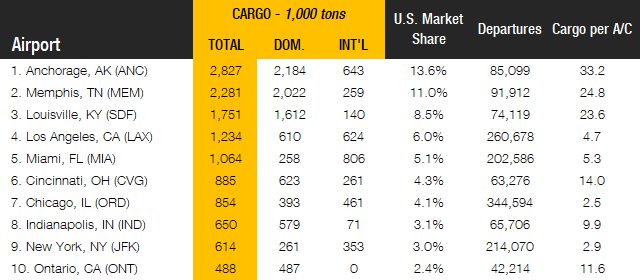

In 2022, airports in the U.S. handled a total of 854.1 million departing passengers, up 29.3 percent from 660.4 million in 2021. Of this total, 759.9 million, or 88.1 percent, were departing for domestic destinations, while the remaining 94.3 million, or 11.9 percent, departed for destinations abroad. By cargo volumes (freight + mail), airports in the U.S. handled 20.7 million tons of departing cargo, down 5.8 percent from 22.0 million in 2021. Of this total, 16.0 million tons, or 77.0 percent, comprised domestic cargo and the remaining 4.7 million tons, or 23.0 percent, comprised international cargo.
COVID-19 was a major blow to the global air transportation industry. The number of passengers departing from U.S. airports plummeted 61 percent in 2020 (from 943.0 million to 370.6 million), with international traffic down nearly 74 percent. Meanwhile, air cargo departing from airports in the U.S. was up 4.8 percent in 2020 (from 19.2 million tons to 20.2 million tons) as COVID fueled a surge in ecommerce sales. Also, demand for products to improve quality of life at home surged during COVID. In 2021, the number of departing passengers at U.S. airports jumped 78 percent to 660.4 million but still remained well below pre-COVID levels, while air cargo had another banner year, adding another 9.1 percent to departing volumes with 22.0 million tons handled.
In 2022, the #1 airport by departing passengers was Atlanta Hartsfield-Jackson (ATL) with 45.6 million, or 5.3 percent of all passengers departing from U.S. airports. Runner-up was Dallas/Fort Worth International Airport (DFW) with 35.4 million passengers (4.1%), followed by Denver International Airport (DEN) in third place with 34.1 million (4.0%). Chicago O’Hare (ORD) with 33.2 million (3.9%) and Los Angeles International (LAX) with 32.7 million (3.8%) take 4th and 5th place, respectively.

In 2022, the #1 airport by tons of departing cargo was Anchorage – Ted Stevens International (ANC) with 2.8 million tons, or 13.6 percent of all cargo departing from U.S. airports. Runner-up was Memphis International (MEM), the FedEx World Hub, with 2.3 million tons (11.0%), followed by Louisville International (SDF), home of the UPS Worldport, in third place with 1.8 million tons (8.5%). Los Angeles International (LAX) with 1.2 million tons (6.0%) and Miami International (MIA) with 1.1 million tons (5.1%) take 4th and 5th place, respectively.
Anchorage – Ted Stevens has experienced rapid freight growth in recent years and took the #1 spot from Memphis International in 2020.

2023 Forecast: As of May 2023, passenger traffic departing from U.S. airports is up 14.4 percent year-on-year, which means that the U.S. air transportation industry is well underway to returning to and even surpassing pre-COVID passenger figures. If the current trajectory continues for the remainder of the year, U.S. airports will have handled 977.4 million departing passengers, compared to 943.0 million in 2019. Air cargo, however, is still returning to normalized levels. Departing volumes were down 5.8 percent in 2022 and are, as of May 2023, down another 12.0 percent this year (year-on-year).
Click the image below to download the full Top 100 US Airports 2022 whitepaper.
Kasper Oestergaard is an expert in aerospace & defense market intelligence, fuel efficiency in civil aviation, defense spending and defense programs. Mr. Oestergaard has a Master's Degree in Finance and International Business from the Aarhus School of Business - Aarhus University in Denmark. He has written four aerospace & defense market intelligence books as well as numerous articles and white papers about European aerospace & defense topics.




